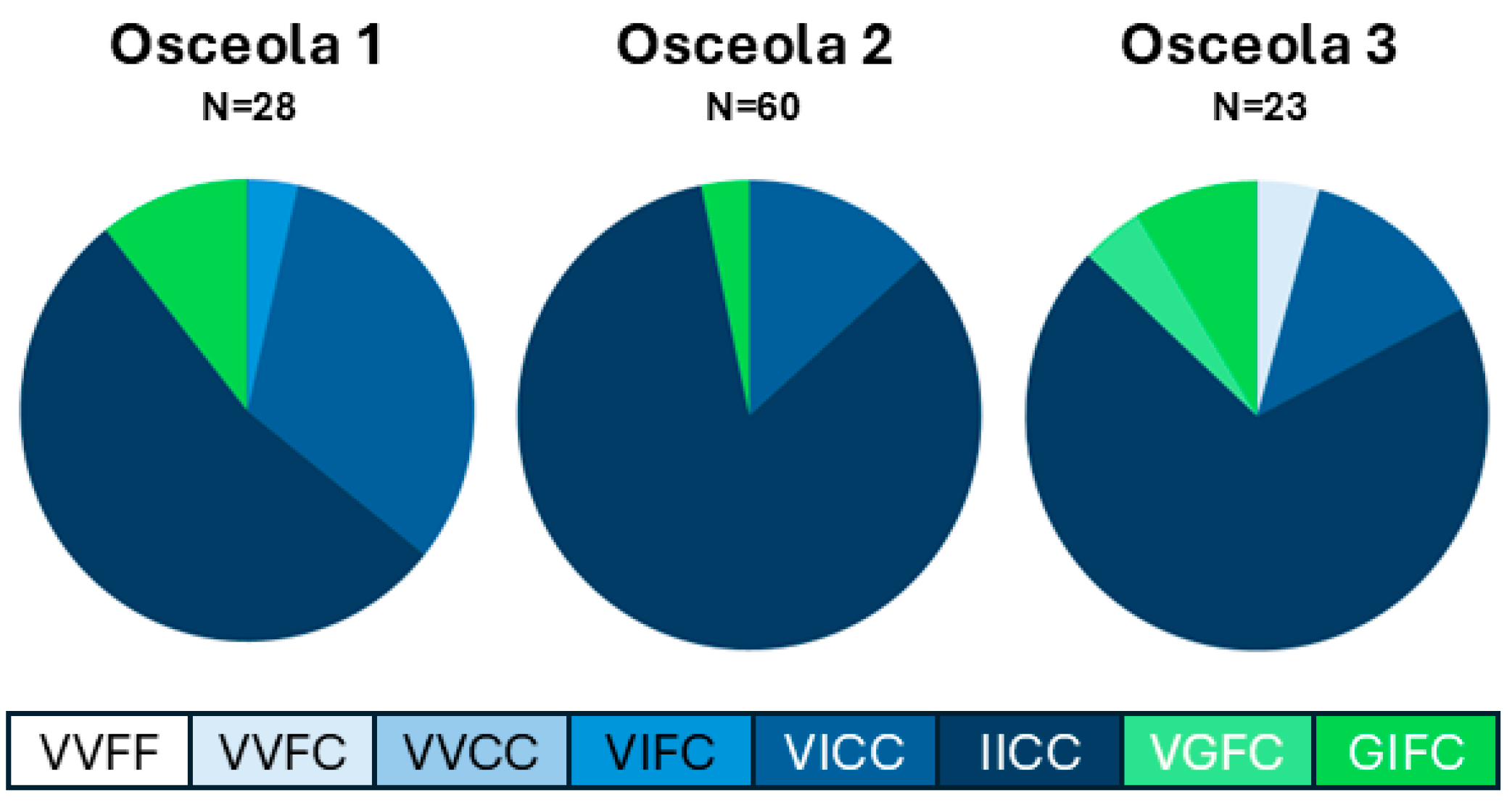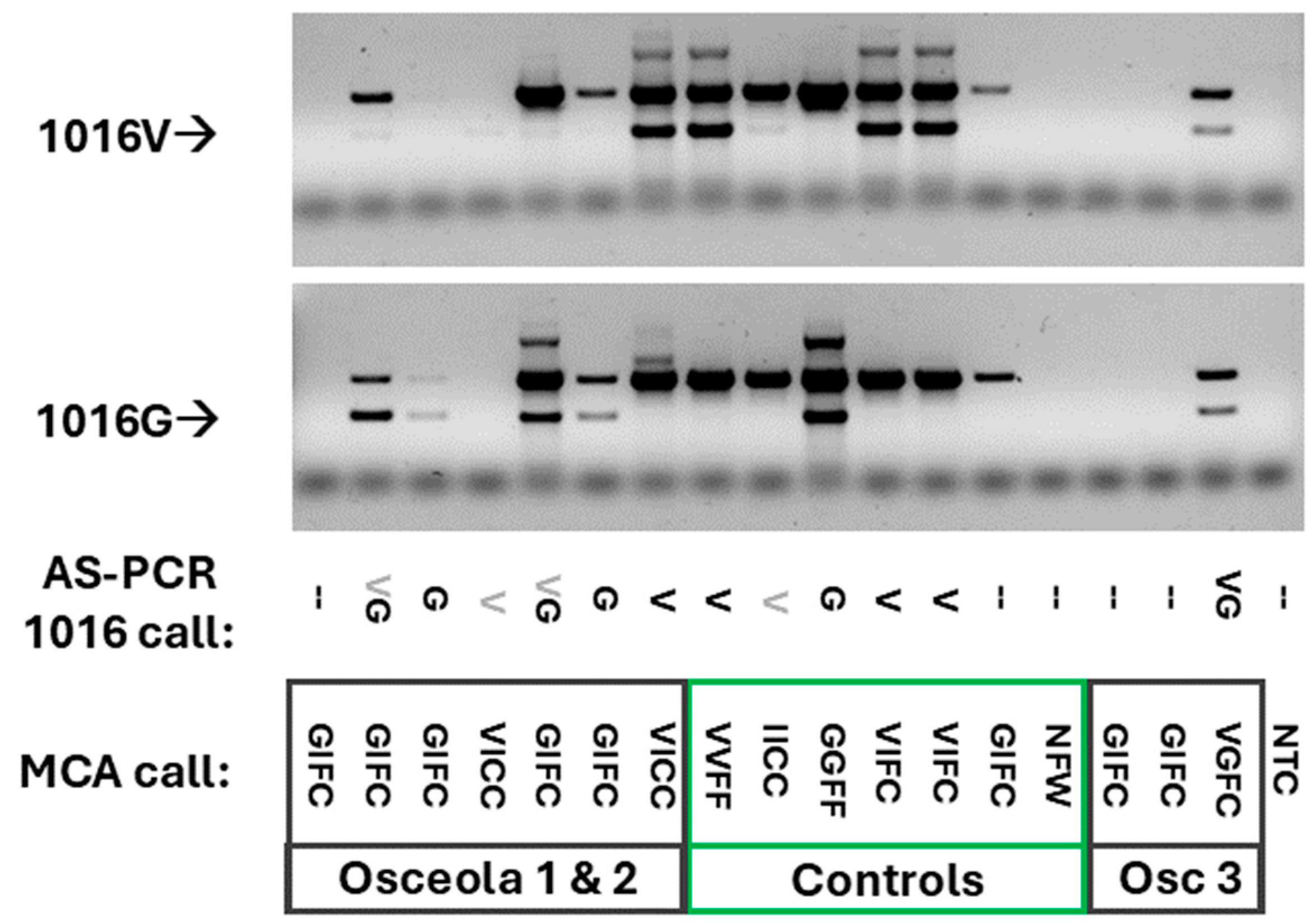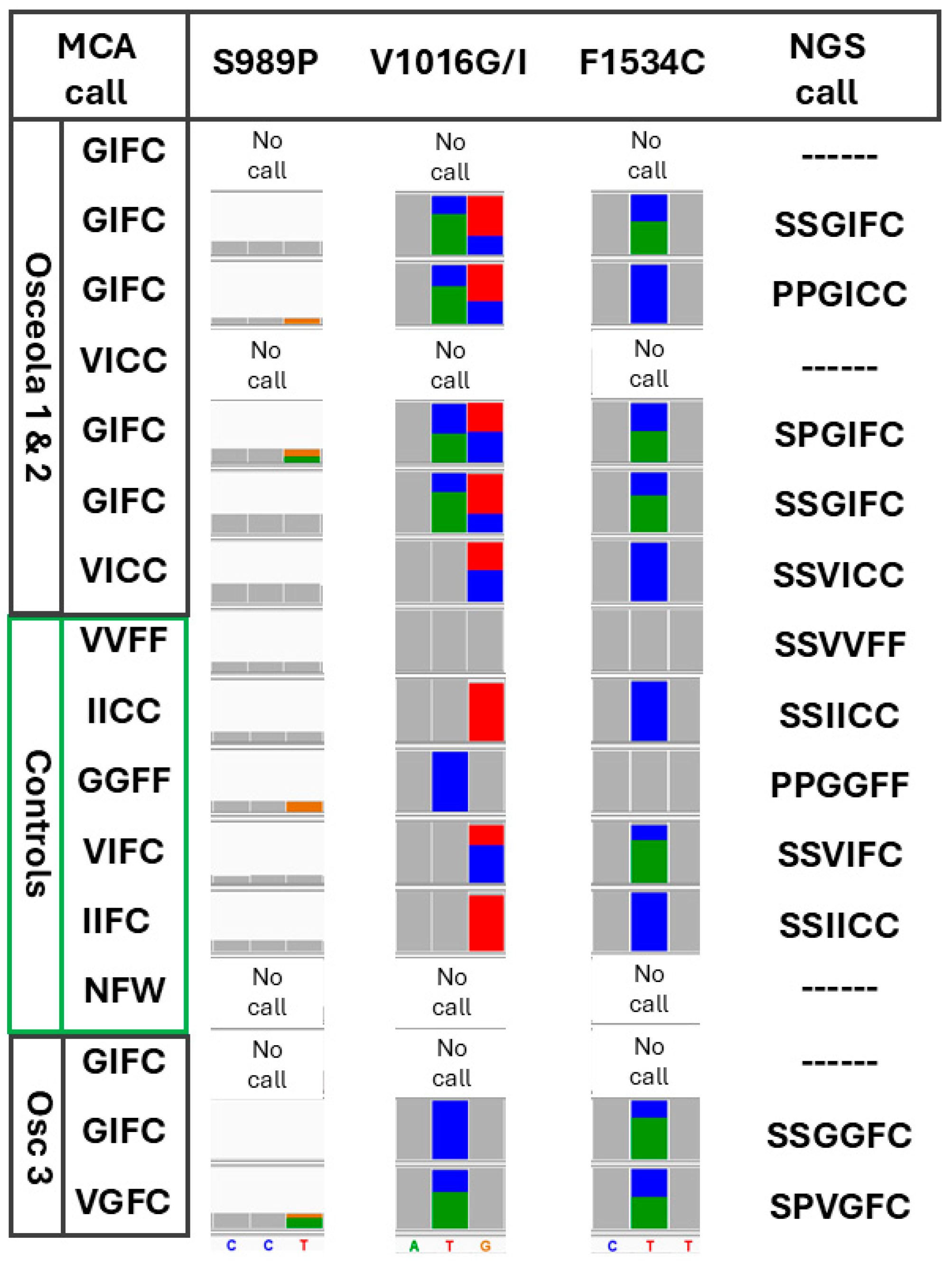Detection of the 1016Gly and 989Pro Knockdown Resistance Mutations in Florida, USA Aedes aegypti
Simple Summary
Abstract
1. Introduction
2. Materials and Methods
2.1. Arthropod Surveillance Collection Procedures
2.2. Control Strains
2.3. Detection of Knockdown Resistance Mutations by Melt Curve Assay
2.4. DNA Purification from Sample Homogenates
2.5. Detection of Knockdown Resistance Mutations by Allele-Specific PCR
2.6. Detection of 1016 Knockdown Resistance Mutations by Sanger Sequencing
2.7. Detection of Knockdown Resistance Mutations and Speciation by Nanopore Sequencing
2.8. Bioinformatic Analysis of Nanopore Sequencing Data
3. Results
3.1. Effect of Non-Target 1016 Alleles in the V1016I and V1016G Melt Curve Assays
3.2. Assessment of V1016I, V1016G, and F1534C in Osceola County, FL by Melt Curve Assay
3.3. Confirmation of the Presence of 1016G in Florida Aedes aegypti by Allele-Specific PCR
3.4. Confirmation of the Presence of 1016G by Sanger Sequencing
3.5. Assessment of 989, 1016, and 1534 kdr Genotypes and Speciation by Next-Generation Sequencing
4. Discussion
4.1. Identification of 1016G and 989P in the Continental US
4.2. Operational Implications of the Introgression of Indopacific kdr Mutations
4.3. Recommendations for Insecticide Resistance Monitoring Inclusive of the Presence of Indopacific kdr Mutations
5. Conclusions
Author Contributions
Funding
Data Availability Statement
Conflicts of Interest
References
- Uribe, L.J. The problems of Aedes aegypti control in the Americas. Bull. Pan. Am. Health Organ. 1983, 17, 133–141. [Google Scholar] [PubMed]
- Nathan, M.B. Critical review of Aedes aegypti control programs in the Caribbean and selected neighboring countries. J. Am. Mosq. Control Assoc. 1993, 9, 1–7. [Google Scholar] [PubMed]
- Camargo, S. History of Aedes aegypti eradication in the Americas. Bull. World Health Organ. 1967, 36, 602–603. [Google Scholar] [PubMed]
- Carvalho, F.D.; Moreira, L.A. Why is Aedes aegypti Linnaeus so Successful as a Species? Neotrop. Entomol. 2017, 46, 243–255. [Google Scholar] [CrossRef] [PubMed]
- Coker, W.Z. The inheritance of DDT resistance in Aedes aegypti. Ann. Trop. Med. Parasitol. 1958, 52, 443–455. [Google Scholar] [CrossRef]
- Pillai, M.K.; Brown, A.W. Physiological and Genetical Studies on Resistance to DDT Substitutes in Aedes Aegypti. J. Econ. Entomol. 1965, 58, 255–266. [Google Scholar] [CrossRef]
- Georghiou, G.P.; Wirth, M.; Tran, H.; Saume, F.; Knudsen, A.B. Potential for organophosphate resistance in Aedes aegypti (Diptera: Culicidae) in the Caribbean area and neighboring countries. J. Med. Entomol. 1987, 24, 290–294. [Google Scholar] [CrossRef]
- Busvine, J.R.; Coker, W.Z. Resistance patterns in DDT-resistant Aedes aegypti. Bull. World Health Organ. 1958, 18, 651–656. [Google Scholar]
- Fox, I. Resistance of Aedes aegypti to certain chlorinated hydrocarbon and organophosphorus insecticides in Puerto Rico. Bull. World Health Organ. 1961, 24, 489–494. [Google Scholar]
- Soderlund, D.M.; Bloomquist, J.R. Molecular mechanisms of insecticide resistance. In Pesticide Resistance in Arthropods; Springer: Boston, MA, USA, 1990; pp. 58–96. [Google Scholar]
- Dong, K.; Valles, S.M.; Scharf, M.E.; Zeichner, B.; Bennett, G.W. The knockdown resistance (kdr) mutation in pyrethroid-resistant German cockroaches. Pestic. Biochem. Physiol. 1998, 60, 195–204. [Google Scholar] [CrossRef]
- Soderlund, D.M. Pyrethroids, knockdown resistance and sodium channels. Pest Manag. Sci. 2008, 64, 610–616. [Google Scholar] [CrossRef] [PubMed]
- Du, Y.; Nomura, Y.; Satar, G.; Hu, Z.; Nauen, R.; He, S.Y.; Zhorov, B.S.; Dong, K. Molecular evidence for dual pyrethroid-receptor sites on a mosquito sodium channel. Proc. Natl. Acad. Sci. USA 2013, 110, 11785–11790. [Google Scholar] [CrossRef] [PubMed]
- Du, Y.; Nomura, Y.; Zhorov, B.S.; Dong, K. Sodium Channel Mutations and Pyrethroid Resistance in Aedes aegypti. Insects 2016, 7, 60. [Google Scholar] [CrossRef] [PubMed]
- Estep, A.S.; Sanscrainte, N.D.; Waits, C.M.; Bernard, S.J.; Lloyd, A.M.; Lucas, K.J.; Buckner, E.A.; Vaidyanathan, R.; Morreale, R.; Conti, L.A.; et al. Quantification of permethrin resistance and kdr alleles in Florida strains of Aedes aegypti (L.) and Aedes albopictus (Skuse). PLoS Negl. Trop. Dis. 2018, 12, e0006544. [Google Scholar] [CrossRef] [PubMed]
- Baltzegar, J.; Vella, M.; Gunning, C.; Vasquez, G.; Astete, H.; Stell, F.; Fisher, M.; Scott, T.W.; Lenhart, A.; Lloyd, A.L.; et al. Rapid evolution of knockdown resistance haplotypes in response to pyrethroid selection in Aedes aegypti. Evol. Appl. 2021, 14, 2098–2113. [Google Scholar] [CrossRef]
- Brito, L.P.; Carrara, L.; de Freitas, R.M.; Lima, J.B.P.; Martins, A.J. Levels of Resistance to Pyrethroid among Distinct kdr Alleles in Aedes aegypti Laboratory Lines and Frequency of kdr Alleles in 27 Natural Populations from Rio de Janeiro, Brazil. BioMed Res. Int. 2018, 2018, 2410819. [Google Scholar] [CrossRef]
- Chung, H.H.; Cheng, I.C.; Chen, Y.C.; Lin, C.; Tomita, T.; Teng, H.J. Voltage-gated sodium channel intron polymorphism and four mutations comprise six haplotypes in an Aedes aegypti population in Taiwan. PLoS Negl. Trop. Dis. 2019, 13, e0007291. [Google Scholar] [CrossRef]
- Smith, L.B.; Kasai, S.; Scott, J.G. Pyrethroid resistance in Aedes aegypti and Aedes albopictus: Important mosquito vectors of human diseases. Pestic. Biochem. Physiol. 2016, 133, 1–12. [Google Scholar] [CrossRef]
- Ahmad, N.A.; Endersby-Harshman, N.M.; Mohd Mazni, N.R.; Mohd Zabari, N.Z.A.; Amran, S.N.S.; Ridhuan Ghazali, M.K.; Abdul Karim, M.A.; Cheong, Y.L.; Sinkins, S.P.; Ahmad, N.W.; et al. Characterization of Sodium Channel Mutations in the Dengue Vector Mosquitoes Aedes aegypti and Aedes albopictus within the Context of Ongoing Wolbachia Releases in Kuala Lumpur, Malaysia. Insects 2020, 11, 529. [Google Scholar] [CrossRef]
- Fan, Y.; Scott, J.G. The F1534C voltage-sensitive sodium channel mutation confers 7- to 16-fold resistance to pyrethroid insecticides in Aedes aegypti. Pest Manag. Sci. 2020, 76, 2251–2259. [Google Scholar] [CrossRef]
- Endersby-Harshman, N.M.; Schmidt, T.L.; Chung, J.; van Rooyen, A.; Weeks, A.R.; Hoffmann, A.A. Heterogeneous genetic invasions of three insecticide resistance mutations in Indo-Pacific populations of Aedes aegypti (L.). Mol. Ecol. 2020, 29, 1628–1641. [Google Scholar] [CrossRef] [PubMed]
- Chung, H.H.; Tsai, C.H.; Teng, H.J.; Tsai, K.H. The role of voltage-gated sodium channel genotypes in pyrethroid resistance in Aedes aegypti in Taiwan. PLoS Negl Trop. Dis. 2022, 16, e0010780. [Google Scholar] [CrossRef] [PubMed]
- Murcia, O.; Henriquez, B.; Castro, A.; Koo, S.; Young, J.; Marquez, R.; Perez, D.; Caceres, L.; Valderrama, A. Presence of the point mutations Val1016Gly in the voltage-gated sodium channel detected in a single mosquito from Panama. Parasit. Vectors 2019, 12, 62. [Google Scholar] [CrossRef] [PubMed]
- Tokponnon, T.F.; Osse, R.; Zoulkifilou, S.D.; Amos, G.; Festus, H.; Idayath, G.; Sidick, A.; Messenger, L.A.; Akogbeto, M. Insecticide Resistance in Aedes aegypti Mosquitoes: Possible Detection of kdr F1534C, S989P, and V1016G Triple Mutation in Benin, West Africa. Insects 2024, 15, 295. [Google Scholar] [CrossRef]
- Kawada, H.; Higa, Y.; Futami, K.; Muranami, Y.; Kawashima, E.; Osei, J.H.; Sakyi, K.Y.; Dadzie, S.; de Souza, D.K.; Appawu, M.; et al. Discovery of Point Mutations in the Voltage-Gated Sodium Channel from African Aedes aegypti Populations: Potential Phylogenetic Reasons for Gene Introgression. PLoS Negl. Trop. Dis. 2016, 10, e0004780. [Google Scholar] [CrossRef]
- Badolo, A.; Sombie, A.; Pignatelli, P.M.; Sanon, A.; Yameogo, F.; Wangrawa, D.W.; Sanon, A.; Kanuka, H.; McCall, P.J.; Weetman, D. Insecticide resistance levels and mechanisms in Aedes aegypti populations in and around Ouagadougou, Burkina Faso. PLoS Negl. Trop. Dis. 2019, 13, e0007439. [Google Scholar] [CrossRef]
- Fagbohun, I.K.; Oyeniyi, T.A.; Idowu, E.T.; Nwanya, O.; Okonkwo, F.; Adesalu, K.O.; Jimoh, R.T.; Oladosu, Y.; Otubanjo, O.A.; Adeogun, A.O. Detection and Co-occurrence of kdr (F1534C and S989P) Mutations in Multiple Insecticides Resistant Aedes aegypti (Diptera: Culicidae) in Nigeria. J. Med. Entomol. 2022, 59, 1741–1748. [Google Scholar] [CrossRef]
- Kandel, Y.; Vulcan, J.; Rodriguez, S.D.; Moore, E.; Chung, H.N.; Mitra, S.; Cordova, J.J.; Martinez, K.J.L.; Moon, A.S.; Kulkarni, A.; et al. Widespread insecticide resistance in Aedes aegypti L. from New Mexico, U.S.A. PLoS ONE 2019, 14, e0212693. [Google Scholar] [CrossRef]
- Scott, M.L.; Hribar, L.J.; Leal, A.L.; McAllister, J.C. Characterization of Pyrethroid Resistance Mechanisms in Aedes aegypti from the Florida Keys. Am. J. Trop. Med. Hyg. 2021, 104, 1111–1122. [Google Scholar] [CrossRef]
- Jensen, B.M.; Althoff, R.A.; Rydberg, S.E.; Royster, E.N.; Estep, A.; Huijben, S. Topical Application Bioassay to Quantify Insecticide Toxicity for Mosquitoes and Fruit Flies. J. Vis. Exp. 2022, 179, e63391. [Google Scholar] [CrossRef]
- Estep, A.S.; Sanscrainte, N.D.; Waits, C.M.; Louton, J.E.; Becnel, J.J. Resistance Status and Resistance Mechanisms in a Strain of Aedes aegypti (Diptera: Culicidae) From Puerto Rico. J. Med. Entomol. 2017, 54, 1643–1648. [Google Scholar] [CrossRef] [PubMed]
- Smith, L.B.; Sears, C.; Sun, H.; Mertz, R.W.; Kasai, S.; Scott, J.G. CYP-mediated resistance and cross-resistance to pyrethroids and organophosphates in Aedes aegypti in the presence and absence of kdr. Pestic. Biochem. Physiol. 2019, 160, 119–126. [Google Scholar] [CrossRef] [PubMed]
- Smith, L.B.; Silva, J.J.; Chen, C.; Harrington, L.C.; Scott, J.G. Fitness costs of individual and combined pyrethroid resistance mechanisms, kdr and CYP-mediated detoxification, in Aedes aegypti. PLoS Negl. Trop. Dis. 2021, 15, e0009271. [Google Scholar] [CrossRef] [PubMed]
- Estep, A.; Kissoon, K.; Saldana, M.; Fredregill, C. Persistent variation in insecticide resistance intensity in container breeding Aedes (Diptera: Culicidae) co-collected in Houston, TX. J. Med. Entomol. 2023, 60, 725–732. [Google Scholar] [CrossRef] [PubMed]
- Saavedra-Rodriguez, K.; Urdaneta-Marquez, L.; Rajatileka, S.; Moulton, M.; Flores, A.E.; Fernandez-Salas, I.; Bisset, J.; Rodriguez, M.; McCall, P.J.; Donnelly, M.J.; et al. A mutation in the voltage-gated sodium channel gene associated with pyrethroid resistance in Latin American Aedes aegypti. Insect Mol. Biol. 2007, 16, 785–798. [Google Scholar] [CrossRef]
- Yanola, J.; Somboon, P.; Walton, C.; Nachaiwieng, W.; Somwang, P.; Prapanthadara, L.A. High-throughput assays for detection of the F1534C mutation in the voltage-gated sodium channel gene in permethrin-resistant Aedes aegypti and the distribution of this mutation throughout Thailand. Trop. Med. Int. Health 2011, 16, 501–509. [Google Scholar] [CrossRef]
- Li, C.X.; Kaufman, P.E.; Xue, R.D.; Zhao, M.H.; Wang, G.; Yan, T.; Guo, X.X.; Zhang, Y.M.; Dong, Y.D.; Xing, D.; et al. Relationship between insecticide resistance and kdr mutations in the dengue vector Aedes aegypti in Southern China. Parasit. Vectors 2015, 8, 325. [Google Scholar] [CrossRef]
- Folmer, O.; Black, M.; Hoeh, W.; Lutz, R.; Vrijenhoek, R. DNA primers for amplification of mitochondrial cytochrome c oxidase subunit I from diverse metazoan invertebrates. Mol. Mar. Biol. Biotechnol. 1994, 3, 294–299. [Google Scholar]
- Li, H. GitHub-lh3/seqtk: Toolkit for processing sequences in FASTA/Q formats. Available online: https://github.com/lh3/seqtk (accessed on 9 June 2024).
- Li, H. Minimap2: Pairwise alignment for nucleotide sequences. Bioinformatics 2018, 34, 3094–3100. [Google Scholar] [CrossRef]
- Li, H. New strategies to improve minimap2 alignment accuracy. Bioinformatics 2021, 37, 4572–4574. [Google Scholar] [CrossRef]
- Thorvaldsdottir, H.; Robinson, J.T.; Mesirov, J.P. Integrative Genomics Viewer (IGV): High-performance genomics data visualization and exploration. Brief Bioinform. 2013, 14, 178–192. [Google Scholar] [CrossRef] [PubMed]
- Parker, C.; Ramirez, D.; Connelly, C.R. Erratum to “State-wide survey of Aedes aegypti and Aedes albopictus (Diptera: Culicidae) in Florida” Journal of Vector Ecology 44 (2): 210–215. 2019. J. Vector Ecol. 2020, 45, 1. [Google Scholar] [CrossRef] [PubMed]
- Mack, L.K.; Kelly, E.T.; Lee, Y.; Brisco, K.K.; Shen, K.V.; Zahid, A.; van Schoor, T.; Cornel, A.J.; Attardo, G.M. Frequency of sodium channel genotypes and association with pyrethrum knockdown time in populations of Californian Aedes aegypti. Parasit. Vectors 2021, 14, 141. [Google Scholar] [CrossRef] [PubMed]
- Hernandez, J.R.; Longnecker, M.; Fredregill, C.L.; Debboun, M.; Pietrantonio, P.V. Kdr genotyping (V1016I, F1534C) of the Nav channel of Aedes aegypti (L.) mosquito populations in Harris County (Houston), Texas, USA, after Permanone 31-66 field tests and its influence on probability of survival. PLoS Negl. Trop. Dis. 2021, 15, e0009833. [Google Scholar] [CrossRef]
- Salinas, W.S.; Feria-Arroyo, T.P.; Vitek, C.J. Temperatures Influence Susceptibility to Insecticides in Aedes aegypti and Aedes albopictus (Diptera: Culicidae) Mosquitoes. Pathogens 2021, 10, 992. [Google Scholar] [CrossRef]
- Altschul, S.F.; Gish, W.; Miller, W.; Myers, E.W.; Lipman, D.J. Basic local alignment search tool. J. Mol. Biol. 1990, 215, 403–410. [Google Scholar] [CrossRef]
- Fan, Y.; O’Grady, P.; Yoshimizu, M.; Ponlawat, A.; Kaufman, P.E.; Scott, J.G. Evidence for both sequential mutations and recombination in the evolution of kdr alleles in Aedes aegypti. PLoS Negl. Trop. Dis. 2020, 14, e0008154. [Google Scholar] [CrossRef]
- Al Nazawi, A.M.; Aqili, J.; Alzahrani, M.; McCall, P.J.; Weetman, D. Combined target site (kdr) mutations play a primary role in highly pyrethroid resistant phenotypes of Aedes aegypti from Saudi Arabia. Parasit. Vectors 2017, 10, 161. [Google Scholar] [CrossRef]
- Hawley, W.A.; Reiter, P.; Copeland, R.S.; Pumpuni, C.B.; Craig, G.B., Jr. Aedes albopictus in North America: Probable introduction in used tires from northern Asia. Science 1987, 236, 1114–1116. [Google Scholar] [CrossRef]
- Craven, R.B.; Eliason, D.A.; Francy, D.B.; Reiter, P.; Campos, E.G.; Jakob, W.L.; Smith, G.C.; Bozzi, C.J.; Moore, C.G.; Maupin, G.O.; et al. Importation of Aedes albopictus and other exotic mosquito species into the United States in used tires from Asia. J. Am. Mosq. Control Assoc. 1988, 4, 138–142. [Google Scholar]
- Laird, M.; Calder, L.; Thornton, R.C.; Syme, R.; Holder, P.W.; Mogi, M. Japanese Aedes albopictus among four mosquito species reaching New Zealand in used tires. J. Am. Mosq. Control Assoc. 1994, 10, 14–23. [Google Scholar] [PubMed]
- Garcia, J.; Chong, M.; Rojas, A.L.; McMillan, W.O.; Bennett, K.L.; Lenhart, A.E.; Chaves, L.F.; Loaiza, J.R. Widespread geographic distribution of Aedes aegypti (Diptera: Culicidae) kdr variants in Panama. J. Med. Entomol. 2024. [Google Scholar] [CrossRef] [PubMed]
- Carrera, L.C.; Piedra, L.; Torres-Cosme, R.; Castillo, A.M.; Bruno, A.; Martínez, D.; Rodríguez, M.M.; Bisset, J.A. Insecticide resistance status and mechanisms in Aedes aegypti and Aedes albopictus from different dengue endemic regions of Panama. Trop. Med. Health 2024, 52, 69. [Google Scholar] [CrossRef] [PubMed]
- Estep, A.S.; Sanscrainte, N.D.; Cuba, I.; Allen, G.M.; Becnel, J.J.; Linthicum, K.J. Failure of Permethrin-Treated Military Uniforms to Protect Against a Laboratory-Maintained Knockdown-Resistant Strain of Aedes aegypti. J. Am. Mosq. Control Assoc. 2020, 36, 127–130. [Google Scholar] [CrossRef]
- Forgash, A.J. History, evolution, and consequences of insecticide resistance. Pestic. Biochem. Physiol. 1984, 22, 178–186. [Google Scholar] [CrossRef]
- Hirata, K.; Komagata, O.; Itokawa, K.; Yamamoto, A.; Tomita, T.; Kasai, S. A single crossing-over event in voltage-sensitive Na+ channel genes may cause critical failure of dengue mosquito control by insecticides. PLoS Negl. Trop. Dis. 2014, 8, e3085. [Google Scholar] [CrossRef]
- South, A.; Lees, R.; Garrod, G.; Carson, J.; Malone, D.; Hastings, I. The role of windows of selection and windows of dominance in the evolution of insecticide resistance in human disease vectors. Evol. Appl. 2020, 13, 738–751. [Google Scholar] [CrossRef]
- Mertz, R.W.; Dressel, A.E.; Fisher, C.R.; Moon, R.D.; Donahue, W.A.; Kasai, S.; Scott, J.G. Frequencies and distribution of kdr and Ace alleles that cause insecticide resistance in house flies in the United States. Pestic. Biochem. Physiol. 2023, 194, 105497. [Google Scholar] [CrossRef]




| Sample | MCA 1016/1534 | AS-PCR 1016 | Sanger 1016 | NGS 989/1016/1534 | COI Accession-%ID |
|---|---|---|---|---|---|
| Osceola 1 | IICC | no call | no call | not tested | not tested |
| Osceola 1 | GIFC | no call | no call | no call | MN299016.1-100% |
| Osceola 1 | GIFC | weakV G | GI | SSGIFC | MK300224.1-99.72% |
| Osceola 1 | GIFC | weakG | no call | PPGICC | MN299016.1-99.57% |
| Osceola 1 | VICC | weakV | no call | no call | MN299016.1-100% |
| Osceola 2 | GIFC | weakV G | GI | SPGIFC | MK300218.1-98.87% |
| Osceola 2 | GIFC | G | GI | SSGIFC | PP902511.1-99.57% |
| Osceola 2 | VICC | V | no call | SSVICC | MN299016.1-100% |
| Control-SSVVFF | VVFF | V | VV | SSVVFF | MN299016.1-99.57% |
| Control-SSIICC | IICC | weakV | II | SSIICC | MN299016.1-100% |
| Control-PPGGFF | GGFF | G | GG | PPGGFF | MK300224.1-99.72% |
| Control-SSVIFC | VIFC | V | VI | SSVIFC | MK300224.1-98.03% |
| Control-SSVIFC | VIFC | V | VI | not tested | not tested |
| Control-SPGIFC | IIFC | no call | II | SSIICC | MK300224.1-99.72% |
| Control-NFW | no call | no call | no call | no call | no call |
| Osceola 3 | GIFC | no call | no call | no call | no call |
| Osceola 3 | GIFC | no call | no call | SSGGFC | PP902511.1-99.72% |
| Osceola 3 | VGFC | V G | G | SPVGFC | MN299016.1-100% |
Disclaimer/Publisher’s Note: The statements, opinions and data contained in all publications are solely those of the individual author(s) and contributor(s) and not of MDPI and/or the editor(s). MDPI and/or the editor(s) disclaim responsibility for any injury to people or property resulting from any ideas, methods, instructions or products referred to in the content. |
© 2024 by the authors. Licensee MDPI, Basel, Switzerland. This article is an open access article distributed under the terms and conditions of the Creative Commons Attribution (CC BY) license (https://creativecommons.org/licenses/by/4.0/).
Share and Cite
Estep, A.S.; Sanscrainte, N.D.; Lamberg, F.; McStoots, D.; Gosselin, S. Detection of the 1016Gly and 989Pro Knockdown Resistance Mutations in Florida, USA Aedes aegypti. Insects 2024, 15, 863. https://doi.org/10.3390/insects15110863
Estep AS, Sanscrainte ND, Lamberg F, McStoots D, Gosselin S. Detection of the 1016Gly and 989Pro Knockdown Resistance Mutations in Florida, USA Aedes aegypti. Insects. 2024; 15(11):863. https://doi.org/10.3390/insects15110863
Chicago/Turabian StyleEstep, Alden S., Neil D. Sanscrainte, Frieda Lamberg, Darrel McStoots, and Susan Gosselin. 2024. "Detection of the 1016Gly and 989Pro Knockdown Resistance Mutations in Florida, USA Aedes aegypti" Insects 15, no. 11: 863. https://doi.org/10.3390/insects15110863
APA StyleEstep, A. S., Sanscrainte, N. D., Lamberg, F., McStoots, D., & Gosselin, S. (2024). Detection of the 1016Gly and 989Pro Knockdown Resistance Mutations in Florida, USA Aedes aegypti. Insects, 15(11), 863. https://doi.org/10.3390/insects15110863





